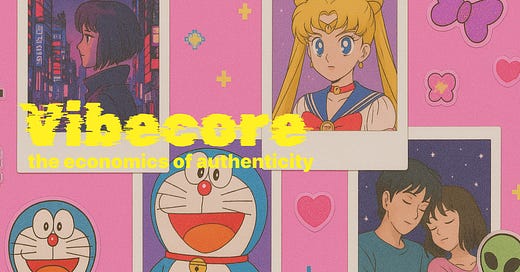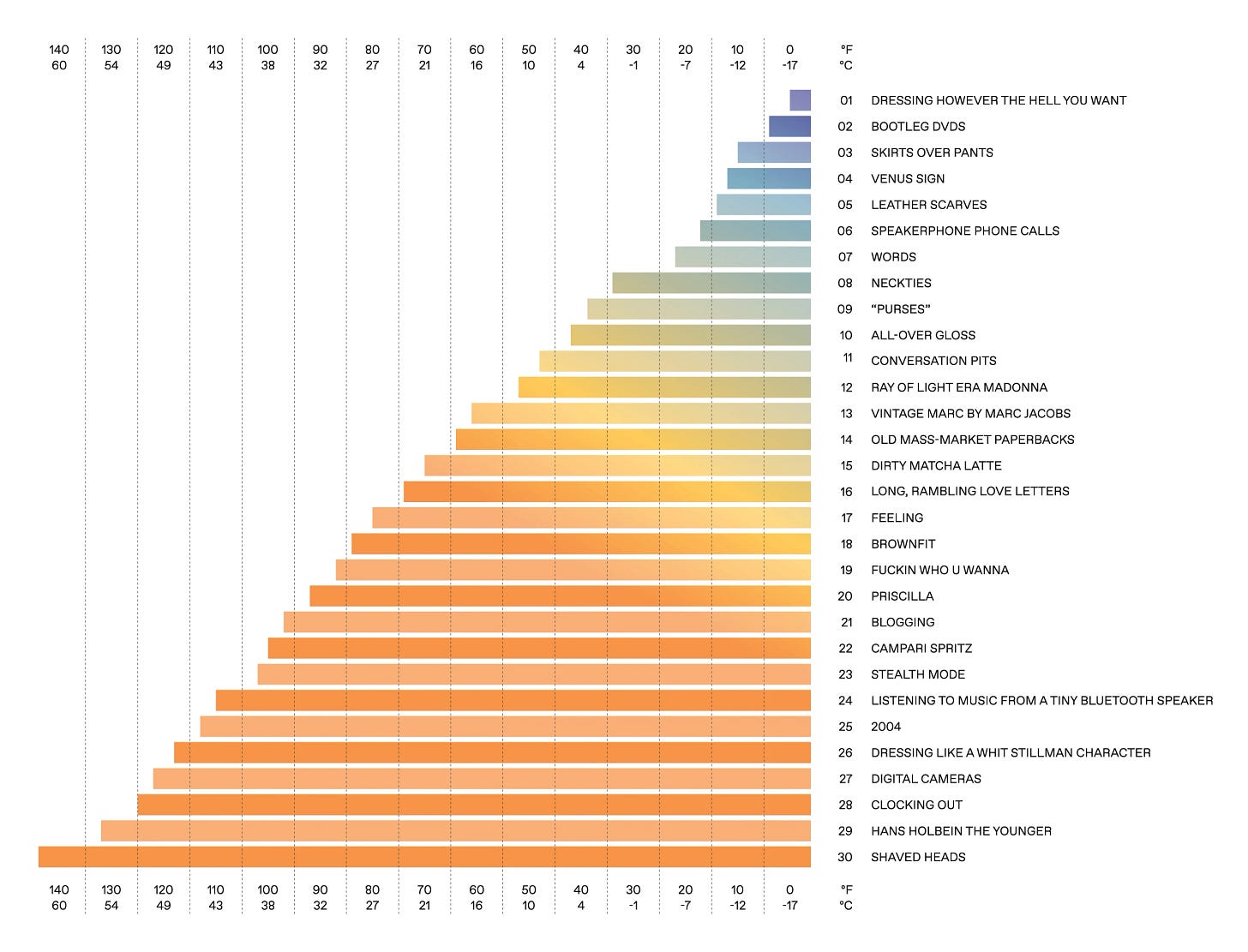Vibecore: the economics of authenticity
Your selfhood becomes both signal and currency: authentic enough to resonate but compressed enough to move seamlessly through the system.
"Tear off the mask. Your face is glorious.” — Rumi
There’s a new crop of companies emerging. VibeGrade for grading, VibeCode, VibeMarketing, and surely soon VibeTrade or VibeWrite, each claiming to distill the mess and mystery of human work into a set of algorithmic instructions. Each taps into our growing addiction: automating daily complexity through our most subjective sensibility—the "vibe."
But you can’t automate the ineffable if you never bothered to access or even define what the ineffable looks like. No algorithm can fetch your “vibe” from ‘Source’, much less train on it, if you don’t have one. Before you can offload discernment, you have to possess some discernment worth offloading.
In 2025, “vibe” is no longer just a whiff of coolness or a fleeting energy in the room—it’s a currency, a badge, a product to be refined, packaged, ranked, and circulated. The industrialization of vibe is not speculative. It's happening in real time.
But what exactly do we mean by “vibe” in this context? The word carries the weight of ancient intuition and Gen Z immediacy, invoked to describe everything from Ovid’s romantic ache to TikTok’s discover page. But as it becomes more central to how we build, buy, and judge, “vibe” splits into two technical domains: first, as a shortcut for translating complex tasks into “feels right” workflows; second, as the externalization of your idiosyncratic, lived taste—your acid jazz playlists, your winter clothing rituals—into something machine-readable and mechanical. It’s this latter phenomenon—the automation and export of personal taste as algorithmic artifact—that’s both new and high-stakes. This essay is about the existential cost of that export.
This only works if you truly know yourself. All this “vibe externalization” assumes you’ve put in the existential legwork of interrogating your preferences, separating signal from noise, distinguishing between the shoes you love and the shoes Instagram loves for you. It presumes you have a coherent vibe to transmit, not just a Pinterest board in search of a personality. Clarity is rare, and the world is relentless with its static.
“Vibe check” has become a kind of ritual—whether in dating, hiring, or even making friends at Barry’s class. It isn’t about superiority, but about resonance: that immediate sense of sync, like two tuning forks suddenly humming together. In the context of “Vibecore,” this means turning authenticity into a practice. Each of us a searching beacon, hoping to find the right echo.
“Today’s narcissistic “achievement-subject” seeks out success above all. Finding success validates the One through the Other. Thereby, the Other is robbed of otherness and degrades into a mirror of the One—a mirror affirming the latter’s image.” — Byun Chul Han, The Agony of Eros
The philosopher BCH examines this in his essays on the crisp, frictionless world of late capitalism. It’s a realm where platforms and markets pose as master preference-matchers. Their promise: convenience, optimization, an elegant dance of endless supply to meet every micro-demand. Dating, he says, morphs into a sophisticated swap-meet for sameness. We swipe to find our own reflection. Narcissus, patron saint of the algorithm, beckons us back to the mirror.
If BCH’s critique is half-right, it’s only half the story. Vibecore doesn't merely flatten us into algorithms; it also incentivizes real self-awareness. In a landscape of AI-generated homogeneity, authentic taste becomes social capital—a career advantage, an entry ticket, a source of relevance.
But here’s where the familiar complaint runs against its limits. The market doesn't want perfectly unique weirdness. It wants vibes that can be both unmistakable and transmissible. This is the strange paradox of our moment: the most valuable selfhood is the one that is scarce enough to be non-fungible, yet legible enough to circulate frictionlessly through the algorithmic and economic marketplace.
The era of “Vibecore” generates a new tension: authenticity becomes a balancing act. Your vibe must be scarce enough to stand out yet legible enough to circulate—unmistakably you, yet easy to monetize. The sharper your selfhood, the greater its market value, but also the greater its vulnerability to being streamlined. The self must become both signal and currency, real enough to resonate but compressed enough to traverse seamlessly through the algorithmic circuits.
This shows up everywhere you look. VibeGrade promises to grade essays not just for correctness, but for a set of subjective rubric circulated in the teacher community. VibeCode’s linter asks not how to standardize, but how to institutionalize your quirks into code that someone else can later recognize and extend. On TikTok, only the clearly articulated and repeatable oddities actually become trends; the rest fall away, unseen.
Even though any “vibe” could, in theory, exist, only the ones that can be easily referenced, transacted, and monetized really circulate and gain momentum. The rest—those that are too slow, ambiguous, or private—tend to sit on the shelf, waiting for a sudden shift in the memeplex, or never catching on at all.
This creates a treadmill of refinement: today’s illiquid vibe can become tomorrow’s gold if the market’s mood swings, or if a meme breaks out and suddenly a once-obscure reference floods into circulation. Most disappear without a trace; a tiny few become the new templates.
So the marketplace fills with hundreds of micro-vibes—some fizzling, some going parabolic for reasons no founder or algorithm can quite engineer. This is the texture of Vibecore in the wild: a constant churn of new signals and stray resonances, where the only pattern is unpredictability and the only certainty is that tomorrow’s winner may be a total outlier today.
But this volatility comes at a cost. As each vibe is surfaced, measured, and compared, what was once an organic signal—an honest resonance—risks being spun into mere spectacle. The transition is subtle but consequential: first, authentic expression is prized for its depth; then, almost imperceptibly, that same expression gets rewarded only if it is packaged for easy uptake—flattened, clipped, remixed for maximal circulation. The reward system has shifted from rewarding what is true to rewarding what is transmissible.
In chasing resonance, we unwittingly privilege those parts of our selves that are most easily indexed and monetized by the system, while the ambiguous, slow, or difficult-to-parse aspects of selfhood get pushed out of sight. In short, the iterative performance and circulation of authenticity threatens to erode the very authenticity it seeks to amplify. What survives the market’s filter are not always the strangest, deepest, or most vital signals, but those most amenable to compression and repetition.
The demand for “vibe” feels endless, but in the rush to commodify it, genuine difference is at risk of being flattened—what Byung-Chul Han describes as the Other being absorbed into the Same. Markets crave individuality, but only when easily indexed and monetized, pushing aside the ambiguous, slow, or subtle aspects of selfhood.
We like to think of weirdness as an asset waiting to be recognized. But sometimes the truest stuff isn’t liquid because it’s not meant to be. The cost of opacity is real: irrelevance, alienation, economic precarity. Still, for every TikTok sound turned viral and monetized, there’s a Telegram channel or Shoegaze Discord or São Paulo drag night where the value of the vibe is precisely that it can’t be captured, indexed, or imitated at scale.
Maybe “cultivating your vibe” is just digital gnōthi seauton—knowing yourself deeply—not another prompt for an API. Simone Weil wrote: “attention, taken to its highest degree, is the same thing as prayer.” In a world eager to collapse us into relatable content, the highest resistance might be radical inward attention: What moves me? What makes me restless? What would I create if no one cared—except the small, stubborn part of me that can’t help itself?
As a founder, I've had sharp product people urge me to clarify and streamline our company story: 'If people can't instantly grok it, they'll bounce.' It's true that legibility transforms viewpoint into product, but with each round of sanding off what was weird or unruly, a subtle estrangement crept in. The energy that drew people initially—something a little off, a little private—grew thinner.
Messiness vanished as we optimized for market-fit. Yet I can't help preserving that edge, haunted by moments when someone said, “I found your thing. I felt seen.” There exists a private space of resonance parallel to the public market—not scale, but intensity, a dignity in risking misunderstanding for the chance to be deeply understood by a few.
The push to make vibes legible and scalable isn’t simply a matter of personal taste, but a reformatting of culture itself. As more of the economy and public conversation demand indexable, transactable identities, the space for the ambiguous, slow-to-surface, or not yet profitable narrows. Complexity and contradiction become costs to be trimmed. Over time, the result isn’t just the loss of some private weirdness, it’s a collective shrinking of possible futures. The market becomes more efficient, but the frontier of what gets seen, rewarded, or remembered continues to narrow.
But maybe this entire framing—scarcity vs. legibility, authenticity as a precious resource at risk of dilution—misses the deeper transformation underway.
The story no longer ends, or even truly pivots, on the fear of flattening. The paradigm shift is that “authenticity” itself is up for reevaluation. What if the endgame of Vibecore is not to preserve a fixed, rare essence, but to transcend the very need for one—to operate from an entirely new playbook, where the ongoing process of recomposing and remixing identity is itself the source of value and resilience?

What if “authenticity” is no longer a question of fidelity to a fixed interior, but instead, the capacity to manufacture and inhabit selves at will, like those viral 3D action packs that went viral. In a world where every trace of personality and preference can be externalized, scored, and swapped, the old “know thyself” imperative gives way to an entirely different survival skill: the ability to shapeshift, remix, and perform. What appears as a tragedy of flattening might secretly be a liberation from the burdens of singularity—a post-individual, distributed identity project rendered possible by digital life.
Maybe the real tension of Vibecore isn’t about defending some secret interiority from algorithmic capture. Maybe our souls were never singular or truly private—always already mosaics, co-authored and recoded by our friends, strangers, bots, scenes, timelines, and memes. But what if the goal isn't defensive authenticity, but something more fluid, collaborative, and ecstatic? A creative act performed with, against, and through the systems capturing us.
Under this lens, the existential risk is not dilution, but becoming unresponsive, losing the capacity to mutate, to play, to generate new configurations when the old ones are commodified. The only authentic act left is perpetual recomposition, refusing to let the algorithm "solve" you.
What, then, is the endgame of Vibecore? It’s not a clean triumph of individuality or a story of total commodification. It’s a recursive, volatile loop—every act of selfhood is a bid in a public game, every fixed form is eventually remixed, every vibe both sampled and regenerated in new contexts. The most valuable move isn’t to retreat or to comply, but to stay in motion, composing new versions of self and scene just ahead of the market’s or the algorithm’s ability to tag and flatten you.
In a world of endless indexing and remix, the rarest resource may be the willingness to mutate, to perform and abandon old selves, to treat identity as a collaborative, living act rather than a possession. The surprise—the real value—emerges not from what you keep hidden, but from what you keep becoming.
Vibecore, at its heart, is about keeping open the possibility of the next surprise: the signal that refuses easy resolution, the self that sits just outside the dropdown menu, the idea that hasn’t yet achieved liquidity, but might in time, change the whole game.












